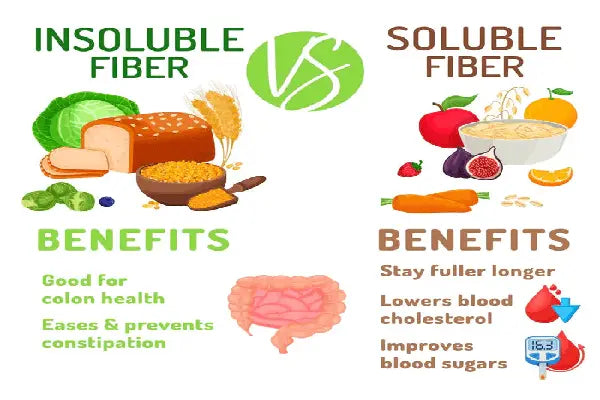
Select the option that best fits you.


What's the first thing that comes to mind when you think about fiber? That it can keep your bowel movements regular and prevent constipation? You're not wrong but there are a ton of other health benefits to getting more fiber in your diet.
It supports healthy digestion, feeds the good bacteria in your gut, and even has a hand in weight loss. Thing is, not all fiber is one and the same. So let's take a look at the different types of fiber and what they mean for not only your gut health but overall health too.
Fiber is a set of carbohydrates that your body can't digest. So essentially, all fiber is indigestible fiber. Your body breaks down most carbohydrates into glucose. However, since our bodies don't have the gastrointestinal enzymes to break down fiber, it passes through your digestive system intact. Fiber foods are natural stool softeners that enable regular bowel movements.
Aside from preventing constipation, research shows that fiber can also improve gut health, lower cholesterol, aid in weight loss, and reduce the risk of heart disease, hypertension, and type 2 diabetes. It's also been shown to reduce the risk of colon cancer .
It's recommended that men aim for at least 35 grams of fiber each day and women 25 grams. However, the average person only consumes about half that, at 15-17 grams per day. Vegetables, fruits, whole grains, lentils, and nuts and seeds are all high in fiber.
As you learned before, there are many different types of fiber. And the way it all gets broken out can be just a bit complex.
The first way to classify the different types of fiber is by breaking it out between dietary fiber and functional fiber. Simply put:
But since breaking fiber out this way tells us nothing about the impact it can have on your health, there are a few alternative methods to consider. You can also categorize fiber based on its solubility, viscosity, and fermentability. On top of that, there's even another category (resistant starch) that often gets lumped in with dietary fibers.
Let's look at each of these categories in more detail below.
Fiber's ability to dissolve in water is known as its solubility. So we can break fiber out as being either soluble fiber or insoluble fiber.
Since our bodies can't digest fiber, it reaches the large intestine in its original form. But this is where fermentable foods and fibers demonstrate their importance. The good bacteria in your colon digests (or ferments) these fibers and uses them for nutrients, which boosts the amount of healthy bacteria in your gut and creates short-chain fatty acids that promote healthy digestion. The best type of fiber foods in this category include legumes like beans, peas, and even peanuts.
Non-fermentable fibers aren't able to be fermented by the gut. Examples of this type of fiber include foods like wheat bran, whole grains, and the skins of certain fruits and vegetables.
Viscosity refers to how thick a substance is. For example, honey is more viscous than milk. When you eat viscous fiber, it solidifies in your stomach and delays digestion. Slowing down digestion decreases your appetite and helps you feel fuller for longer, which is especially good for weight loss. In fact, a review of 62 trials published by the American Journal of Clinical Nutrition found that consuming viscous fiber led to significant weight loss.
Examples of foods high in viscous fiber includer asparagus, legumes, oats, and flaxseed.
Resistant starches are also known as indigestible starches. As it pertains to the gut, they're similar to soluble, fermentable fiber. Resistant starches are known for filling you up and regulating blood sugar levels. They're also good for your heart considering they lower cholesterol by preventing it from entering your bloodstream.
The food list on resistant starches could go on forever, but here are a few of them: Oats, barley, beans and legumes, potatoes, and green bananas.
If you have a stomach condition like IBS or IBD, a low FODMAP diet could be just what you need to help manage the symptoms. However, this could present some issues. On one hand, this type of diet often limits your fiber intake.
But as we've discussed, fiber is key for keeping your bowels regular, preventing constipation, and a variety of other health benefits, such as feeding healthy gut bacteria and reducing the risk of disease. But then again, eating more fiber can cause symptoms of your intestinal disorder (like gas, bloating, or stomach discomfort) to flare up.
So what's the solution here? The key, according to research, is to gradually increase your fiber intake, focusing on soluble fiber foods that are also low in fermentable carbs (e.g. low FODMAP fibers). This feeds the beneficial bacteria that ferment fiber without causing gas, bloating, and pain.
Getting plenty of fiber supports a healthy gut and can reduce your risk of heart disease, type 2 diabetes, and even colon cancer. Types of fiber foods include vegetables, fruits, legumes, oats, and nuts and seeds
Keep in mind there are many different types of fiber. There's soluble vs. insoluble fiber, fermentable fiber, and viscous fiber. Don't forget about resistant starches too, which belong in the soluble, fermentable fiber category.
Try not to get too hung up on the different types of fiber. As long as you're consuming plenty of nutrient-dense, plant-based foods in your diet, then everything will take care of itself.
Looking for quick ways to improve your gut health? It all starts in the morning! Here are 7 gut-friendly breakfast options to get your day started in the right direction.
We can support you on the path to better wellness by providing you with the information you need to start the conversation, and we can provide tailored support for your provider.
